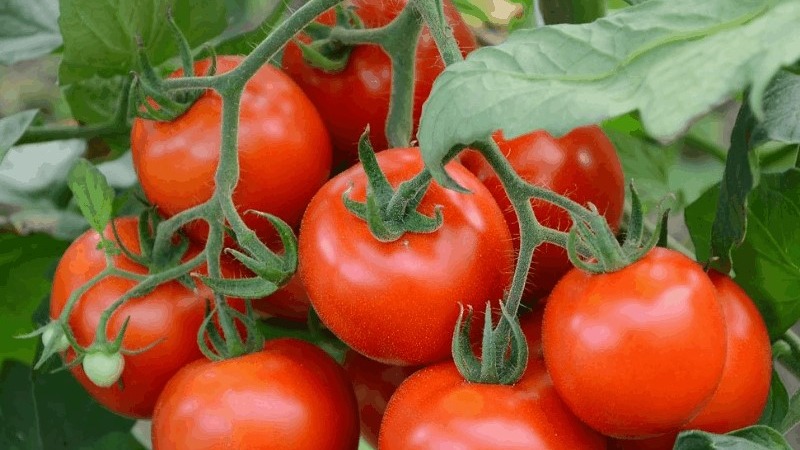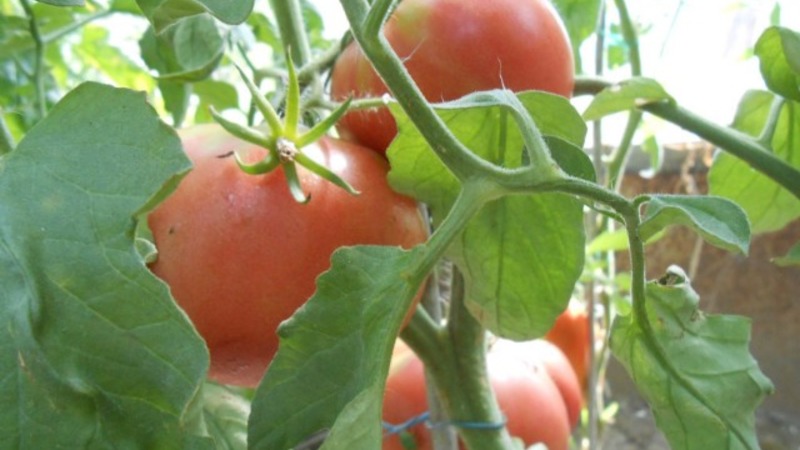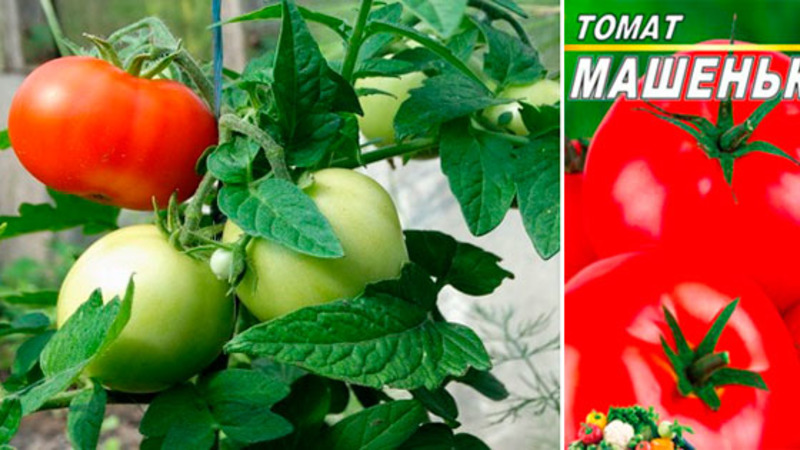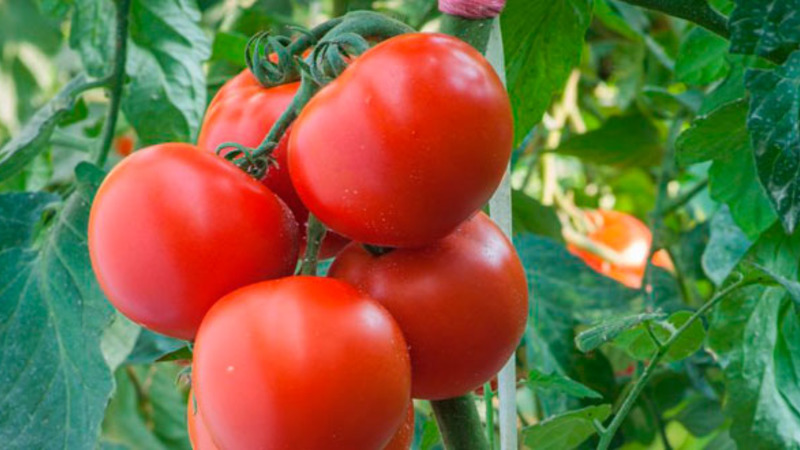A good choice even for novice gardeners is the Mashenka tomato and the secrets of growing it to get a rich harvest
The Mashenka variety has won fans with its high yield, immunity to diseases, reliable reviews and simple agricultural technology. The tomato looks great in photographs, arousing the interest of novice and experienced vegetable growers. Gardeners are sure that the variety will not let you down either in dry or cool summers and will always delight you with delicious fruits. The culture was bred in Altai and is rightfully recognized as one of the best new varieties.
The rules for growing care, a detailed description of its characteristics - in our article.
The content of the article
Characteristics and description of the variety
The bush is indeterminate, tall, not standard. Height up to 2 m, sturdy stem. The leaves are medium in size, bright green in color. The first brush is formed over 10 leaves, the next ones - every 3 leaves.
reference! The indeterminate type takes root better in the southern regions.
Mid-season species, from the moment of emergence to full maturation, 110-118 days pass.
It is highly resistant to the main diseases of the nightshade family, for example: tobacco mosaic, late blight, fusarium, alternaria.
The yield is high, up to 7-8 kg of vegetables can be harvested from one plant, from 1 sq. m up to 27 kg.
The culture needs binding and pinning.
Recommended for growing outdoors and in greenhouse conditions.
The fruits are large, average weight 210-280 g, round shape, deep red color, dense skin. There are 4-6 seed chambers, there are many seeds. The taste is sweet and sour, high in vitamins, pectins, minerals, proteins and organic acids.
The use of vegetables is universal, ideal for fresh salads and hot dishes. Used for the preparation of tomato products: sauces, ketchups, juices, adjika, lecho. Do not lose their taste in barrel pickles.
Long-term storage, despite the dense skin, is not subject. Vegetables retain their appearance and taste for three weeks.
The photo shows Mashenka tomatoes.

How to grow seedlings
Sowing seeds begins 60 days before planting seedlings in the ground. Before sowing, the seeds are checked for germination using a saline solution, placing the seed in it for 25 minutes. Seeds that have floated to the surface are not suitable for sowing.
The remaining grains are treated in a weak solution of potassium permanganate, which is necessary for their disinfection. Then washed with water and dried. Before sowing, the seeds are treated with a growth stimulator to improve germination.
You can sow in a common container or in individual containers. The soil is prepared from garden soil, river sand and peat in equal proportions. Holes are made at the bottom of the planting container, which further helps to get rid of excess moisture. The prepared soil is disinfected with a solution of dark-colored potassium permanganate.
The grains are laid to a depth of 2 cm, the ground is leveled from above and moistened with a spray bottle. The containers are covered with foil or glass and left in a warm room with an air temperature of at least 22 ° C.
When the first shoots appear, the film is removed, and the planting containers are rearranged in a well-lit place. Seedlings need daylight hours for 13-14 hours, therefore, with a lack of daylight, they are illuminated with fluorescent lamps.
Water the young bushes as the top layer of the soil dries up with warm, settled water from a shallow watering can.
After the formation of two true leaves, the seedlings dive, seating them in separate containers.
reference! Picking helps to select stronger plants and promotes better root development.
10 days before planting seedlings in open ground, they begin to harden it. The hardening procedure consists in keeping the seedlings outside for two hours. This time gradually increases to 18 hours. Do not forget about the temperature drop at night to 13 ° C. This factor also helps to strengthen young bushes and allows them to quickly adapt to new habitat conditions.
How to grow tomatoes
After 60 days, the seedlings are ready to be transplanted to a permanent place. The beds are chosen in a sunny place, protected from drafts. It is not recommended to plant tomatoes in the land where the crops of the same family previously grew. Good predecessors for tomato crops are carrots, cabbage, herbs, legumes. If a transplant is planned in a greenhouse where tomatoes previously grew, it is necessary to change the topsoil.
The earth is pre-dug up and complex mineral fertilizers or organic matter are applied. It is undesirable to apply fresh manure before planting tomatoes, this will lead to an increase in green mass, and a minimum amount of nutrients will be consumed for the formation of fruits.
Planting pattern - 70 cm distance between seedlings, 40 cm - between rows. For 1 sq. m have no more than three bushes.
Before planting seedlings, 1 tbsp is added to each hole 15 cm deep. l superphosphate and potassium sulfate.
They are transplanted on a cloudy day or in the evening, which contributes to a faster adaptation of seedlings in a new place.
After transplanting, the seedlings are watered moderately and left unattended for 5-6 days. Regular watering begins as soon as the seedlings are established in open beds. Water it sparingly, without flooding the plants, under the root, without falling on the leaves. For irrigation, use warm, settled water. The culture responds well to drip irrigation.
After each watering, the soil is loosened and hilled. These procedures improve oxygen access to the roots, which ensures the full growth and development of plants.
For a large retention of moisture in the beds, they are mulched. Mulching also acts as a preventive measure in pest control.
Feed 3 times a season with mineral or organic fertilizers. The first time - during flowering, the second feeding is given during the formation of the fruits, and the third time is fed during the fruiting period. An infusion of mullein, diluted in a ratio of 1:15 or bird droppings in the same ratio, is suitable as organic matter.
reference! Organic fertilizers must be diluted in small quantities to avoid root burns.
Culture needs a must pinching... The plant is formed into 1 or 2 stems, removing all stepchildren. To stop growth, pinch the top. Trunk tie up to a vertical or horizontal support, otherwise it will break under the weight of the fruit. As they grow, they are fixed to the supports and branches.
Diseases and pests
The variety has established itself as immune to the main diseases of the nightshade family. She is distinguished by increased immunity, which allows her to remain healthy and unharmed throughout the season. Nevertheless, one should not forget about simple preventive measures that do not take time and effort, only contribute to further strengthening the culture.
Such measures include moderate watering, systematic loosening of the soil and removal of weeds from the roots. Weeds often harbor a large number of parasites that can cause considerable harm to plants.
From insect pests, aphids and scoop caterpillars should be wary. Soap solution helps from aphids, with which the stems of the bushes are treated. But at the same time it is necessary to watch so that the solution does not fall on the ground.
Important. Scoop- this is a butterfly, its caterpillars multiply rapidly and harm both the plant itself and the fruits. They are saved from a decoction of burdock, which is sprayed on all plants, and pheromone traps are arranged on adults.
It is also necessary to regularly inspect the seedlings for the presence of pests. This simple method will help rid your crop of parasitic insects.
The nuances of growing in open ground and in a greenhouse
The tomato variety Mashenka is recommended for cultivation in the Central regions, Central Black Earth and the North Caucasus. It is quite suitable for cultivation in the Volga region, in the Urals, in Western and Eastern Siberia. But in those regions that are characterized by too short summers, it is advised to breed in greenhouses.
In closed structures, higher yields are noted than in open ground, but the plants themselves will be higher. Therefore, pinching of greenhouse plants is mandatory.
In open beds, the culture is more susceptible to attacks by pests of the insect of the world, and in a greenhouse, the likelihood of developing fungal diseases is higher. This is due to the increased air temperature and waterlogging. Therefore, to prevent diseases, regularly ventilate closed structures.
Of the pests in the greenhouse, the spider mite is dangerous. He loves greenhouse conditions, but the regular influx of fresh air destroys his usual habitat.
Harvesting and application of the crop
Fruit ripening is amicable, almost simultaneous. Aging takes place with whole brushes, which makes them easy to collect.
The use of ripe vegetables is universal: they are ideally combined in summer salads with other vegetables, this is a good basis for the first, hot dishes and sauces. Tomatoes are great when baked with meat.
Tomato products are prepared from them, such as: lecho, ketchup, juices, pastes, adjika. They preserve taste perfectly in barrel pickles and marinades. But due to their large size, they are not suitable for whole-fruit canning.
Despite the dense skin, ripe vegetables cannot be stored for a long time; they are usually stored for no more than 2-3 weeks. Otherwise, tomatoes will lose their presentation and taste.
Advantages and disadvantages of the variety
The main advantage is high yield. From 1 sq. m, up to 26-28 kg of ripe vegetables are harvested. Such record figures are mainly possible only in greenhouse conditions.
But culture is not the only positive side:
- endurance, resistance to heat and cold;
- adaptation to any weather conditions;
- immunity to diseases of the nightshade family;
- unpretentious care;
- simultaneous ripening of fruits;
- large fruits;
- great taste;
- versatility in application;
- the ability to independently select seeds for the next planting.
Some disadvantages of the variety:
- pinching is required;
- garter required;
- short shelf life of ripe fruits.

Farmers reviews
The reviews of those who planted these tomatoes unanimously evaluate Mashenka as a reliable variety that should definitely be grown on your site. Amicable ripening and a high quantitative indicator are especially distinguished. Here are the opinions of some gardeners:
Natalia, Zelenograd:
“I have been growing for several years. The main advantages of culture: unpretentiousness, good fruiting, excellent presentation. I like the fact that seeds from ripe vegetables can be reused. "
Elena, Krasnodar:
“I love working in the garden. For the second year in a row I grow Mashenka. Care consists in timely watering, garter, pinching and feeding. I collect 25 kg of fruits from a square meter. The tomatoes are first class. All winter with vegetables. "
Conclusion
Tomatoes Mashenka from Biotechnika have long been loved by gardeners for their high yield and simple cultivation techniques. The variety is distinguished by increased immunity to diseases - this is another plus that attracts the attention of tomato lovers.The culture is so unpretentious that any beginner who wants to plunge into the country chores will be satisfied with the final result.